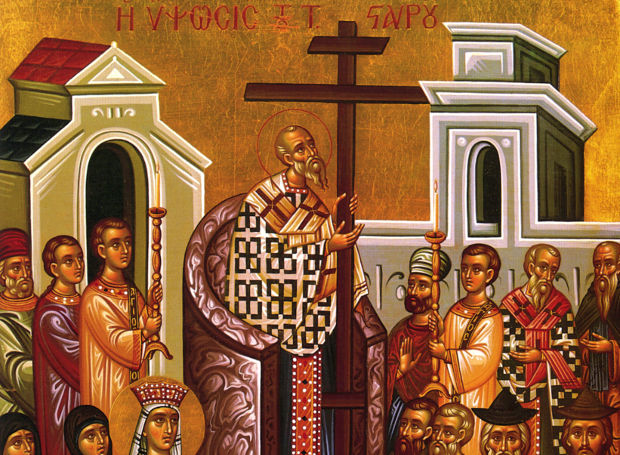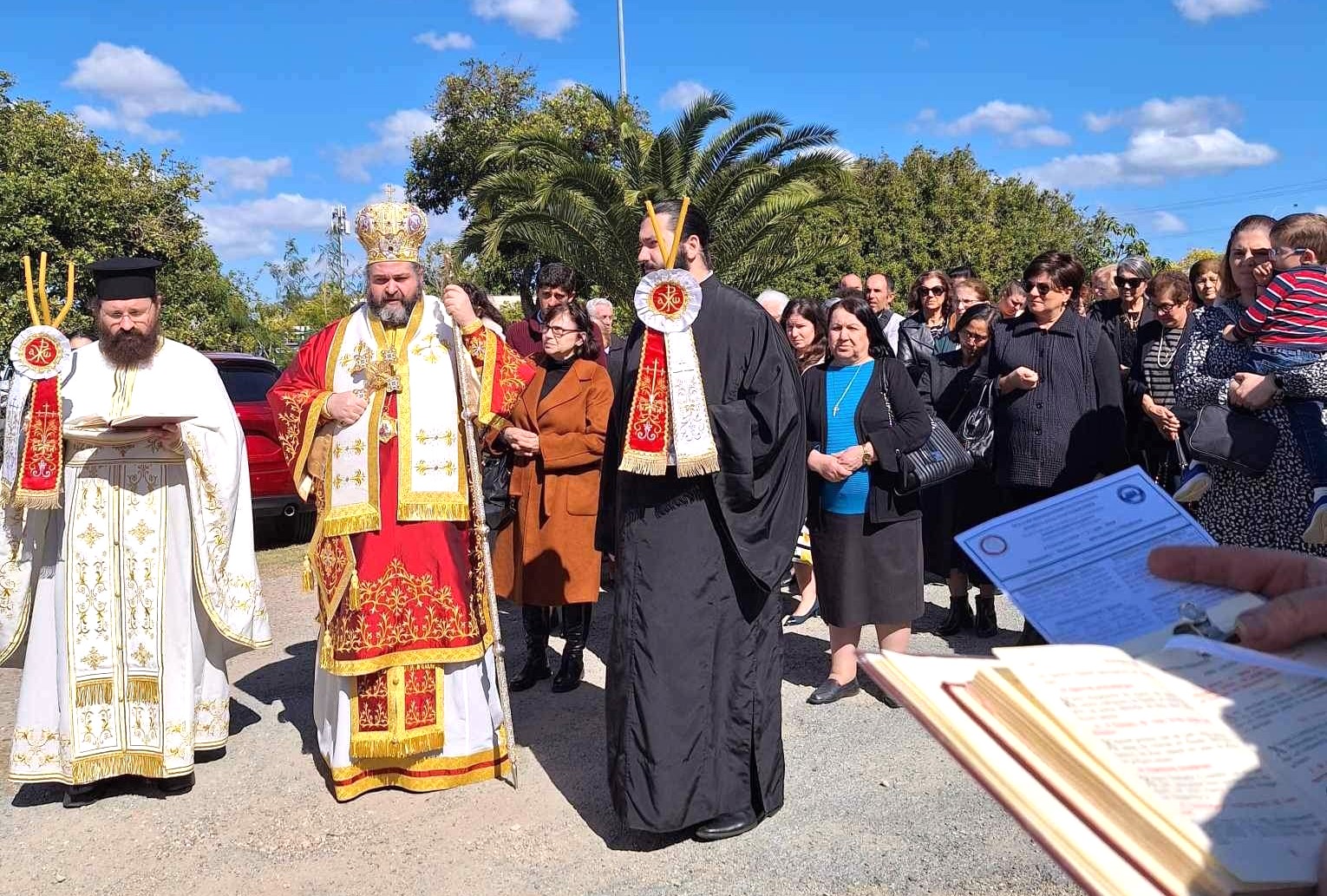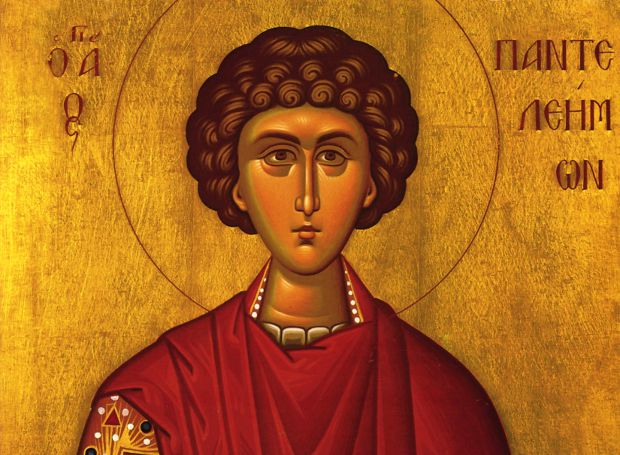The Universal Exaltation of the Precious and Life-Giving Cross (14 September)


The pagan Roman Emperors tried to obliterate the holy places where our Lord Jesus Christ suffered and rose from the dead, so that they would be forgotten. Emperor Hadrian (117-138) ordered that Golgotha and the Lord’s Sepulchre be buried, and that a temple in honor of the pagan “goddess” Venus and a statue of Jupiter be placed there.
Pagans gathered at this place and offered sacrifice to idols. Eventually after 300 years, by Divine Providence, the Christian holy places, the Sepulchre of the Lord, and the Life-giving Cross, were discovered and opened for veneration. This took place under Emperor Constantine the Great (306-337) after his victory over Maxentius (in 312), who ruled the Western part of the Roman Empire, and over Licinius, the ruler of its Eastern part. In the year 323 Constantine became the sole ruler of the vast Roman Empire.
In 313 Saint Constantine issued the Edict of Milan, by which Christianity was legalized and persecutions against Christians in the Western half of the Empire were stopped. Although Licinius had signed the Edict of Milan in order to oblige Constantine, he continued his cruel persecutions against Christians. Only after his conclusive defeat did the Edict of Milan extend also to the Eastern part of the Empire. The Holy Equal of the Apostles Emperor Constantine, triumphing over his enemies in three wars, with God’s assistance, had seen the Sign of the Cross in the heavens. Written beneath were the words: “By this you shall conquer.”
Ardently desiring to find the Cross upon which our Lord Jesus Christ was crucified, Saint Constantine sent his mother, the pious Empress Helen (May 21), to Jerusalem, providing her with a letter to Saint Makarios, the Patriarch of Jerusalem. Saint Helen journeyed to the holy places connected with the earthly life of the Savior, building more than 80 churches, at Bethlehem the birthplace of Christ, and on the Mount of Olives where the Lord ascended to Heaven, and at Gethsemane where the Savior prayed before His sufferings, and where the Mother of God was buried after her Dormition.
Although the holy Empress Helen was no longer young, she set about completing the task with enthusiasm. In her search for the Life-giving Cross, she questioned both Christians and Jews, but for a long time her search remained unsuccessful. Finally, she was directed to a certain elderly Jew named Jude who stated that the Cross was buried beneath the temple of Venus. They demolished the pagan temple and, after praying, they began to excavate the ground. Soon the Lord’s Tomb was uncovered. Not far from it were three crosses, and a board with the inscription ordered by Pilate, and four nails which had pierced the Lord’s Body (March 6).
In order to discover on which of the three crosses the Savior had been crucified, Patriarch Makarios alternately touched the crosses to a corpse. When the Cross of the Lord touched the dead man, he was restored to life. After witnessing the raising of the dead man, everyone was convinced that the Life-giving Cross had been found.
Christians came in a huge crowds to venerate the Holy Cross, beseeching Saint Makarios to lift the Cross, so that those far off could see it. Then the Patriarch and other spiritual leaders lifted the Holy Cross, and the people prostrated themselves before the Honorable Wood, saying “Lord have mercy.” This solemn event occurred in the year 326.
During the discovery of the Life-giving Cross another miracle took place: a woman who was close to death was healed by the shadow of the Holy Cross. The elderly Jude (October 28) and other Jews believed in Christ and were baptized. Jude was given the name Kyriakos, and later he was consecrated as the Bishop of Jerusalem. He suffered a martyr’s death for Christ during the reign of Emperor Julian the Apostate (361-363).
Saint Helen took part of the Life-giving Wood and nails with her to Constantinople. Saint Constantine ordered a majestic and spacious church to built at Jerusalem in honor of the Resurrection of Christ, also including under its roof the Life-giving Tomb of the Lord and Golgotha. The church was built in ten years. Saint Helen did not survive until the dedication of the church, she reposed in the year 327. The church was consecrated on September 13, 335. On the following day, September 14, the festal celebration of the Exaltation of the Honorable and Life-giving Cross was established.
Another event connected to the Cross of the Lord is remembered also on this day: its return to Jerusalem from Persia after a fourteen year captivity. During the reign of the Byzantine Emperor Phokas (602-610) the Persian king Khozróēs II attacked Constantinople defeated the Greek army, plundered Jerusalem, capturing both the Life-giving Cross of the Lord and the Holy Patriarch Zachariah (609-633).
The Cross remained in Persia for fourteen years, and only under Emperor Herakleios (610-641), who defeated Khozróēs and concluded peace with his successor and son Syroes, was the Lord’s Cross returned to the Christians.
With great solemnity the Life-giving Cross was transferred to Jerusalem. Emperor Herakleios, wearing a crown and his royal purple garments carried the Cross of Christ. The Emperor was accompanied by Patriarch Zachariah. At the gates by which they ascended Golgotha, the Emperor stopped suddenly and was unable to proceed. The holy Patriarch explained to the Emperor that an Angel of the Lord was blocking his way. Herakleios was told to remove his royal trappings and to walk barefoot, since He Who bore the Cross for the salvation of the world had made His way to Golgotha in all humility. Then Herakleios donned plain clothes, and without further hindrance, carried the Cross of Christ into the church.
In a sermon on the Exaltation of the Cross, Saint Andrew of Crete (July 4) says: “The Cross is exalted, and everything true is gathered together, the Cross is exalted, and the city makes solemn, and the people celebrate the feast.”
Saint Helen, the mother of Saint Constantine the Great, when she was already advanced in years, undertook, in her great piety, the hardships of a journey to Jerusalem in search of the cross, about the year 325. A temple to Aphrodite had been raised up by the Emperor Hadrian upon Golgotha, to defile and cover with oblivion the place where the saving Passion had been suffered. The venerable Helen had the statue of Aphrodite destroyed, and the earth removed, revealing the Tomb of our Lord, and three crosses. Of these, it was believed that one must be that of our Lord, the other two of the thieves crucified with Him; but Saint Helen was at a loss which one might be the Wood of our salvation. At the inspiration of Saint Macarius, Archbishop of Jerusalem, a lady of Jerusalem, who was already at the point of death from a certain disease, was brought to touch the crosses, and as soon as she came near to the Cross of our Lord, she was made perfectly whole. Consequently, the precious Cross was lifted on high by Archbishop Macarius of Jerusalem; as he stood on the ambo, and when the people beheld it, they cried out, “Lord have mercy.” It should be noted that after its discovery, a portion of the venerable Cross was taken to Constantinople as a blessing. The rest was left in Jerusalem in the magnificent church built by Saint Helen, until the year 614. At that time, the Persians plundered Palestine and took the Cross to their own country (see Jan. 22, Saint Anastasius the Persian). Late, in the year 628, Emperor Heraclius set out on a military campaign, retrieved the Cross, and after bringing it to Constantinople, himself escorted it back to Jerusalem, where he restored it to its place.
Rest from labour. A Fast is observed today, whatever day of the week it may be.
Two events in connection with the Honorable Cross of Christ are commemorated on this day: first, the finding of the Honorable Cross on Golgotha and second, the return of the Honorable Cross from Persia to Jerusalem. Visiting the Holy Land, the holy Empress Helena decided to find the Honorable Cross of Christ. An old Jewish man named Judah was the only one who knew where the Cross was located, and, constrained by the empress, he revealed that the Cross was buried under the temple of Venus that Emperor Hadrian had built on Golgotha. The empress ordered that this idolatrous temple be razed and, having dug deep below it, found three crosses. While the empress pondered on how to recognize which of these was the Cross of Christ, a funeral procession passed by. Patriarch Macarius told them to place the crosses, one by one, on the dead man.
When they placed the first and second cross on the dead man, the dead man lay unchanged. When they placed the third cross on him, the dead man came back to life. By this they knew that this was the Precious and Life-giving Cross of Christ. They then placed the Cross on a sick woman, and she became well. The patriarch elevated the Cross for all the people to see, and the people sang with tears: “Lord, have mercy!” Empress Helena had a silver case made and set the Honorable Cross in it. Later, the Persian Emperor Chozroes conquered Jerusalem, enslaved many people, and took the Lord’s Cross to Persia.
The Cross remained in Persia for fourteen years. In the year 628 A.D. the Greek Emperor Heraclius defeated Chozroes and, with much ceremony, returned the Cross to Jerusalem. As he entered the city Emperor Heraclius carried the Cross on his back, but suddenly was unable to take another step. Patriarch Zacharias saw an angel preventing the emperor from bearing the Cross on the same path that the Lord had walked barefoot and humiliated. The patriarch communicated this vision to the emperor. The emperor removed his raiment and, in ragged attire and barefoot, took up the Cross, carried it to Golgotha, and placed it in the Church of the Resurrection, to the joy and consolation of the whole Christian world.
Apolytikion of Elevation of the Holy Cross
First Tone
Lord, save Your people and bless Your inheritance, granting our rulers to prevail over adversaries, and protecting Your commonwealth by Your Cross.
Kontakion of Elevation of the Holy Cross
Fourth Tone
Lifted up on the Cross by Your free will, Christ God, grant mercies to the new commonwealth that bears Your name. Gladden our faithful rulers by Your power, giving them victories over their adversaries. May Your alliance be for them a weapon for peace, an invincible standard.
Source: oca.org / goarch.org / westserbdio.org





